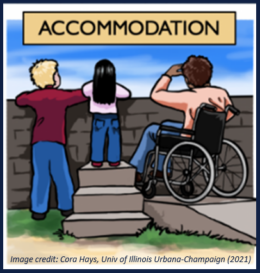Common Accessibility Issues
This page offers brief descriptions of some common accessibility issues affecting UNCG students, how those issues affect their interactions with learning experiences, and typical accommodations which assist with those issues.
About Accommodations
The federal government defines an accommodation as a just-in-time adaptation or adjustment to meet the needs of a specific individual or group. The adjustment addresses an immediate need and is often applied to specific situations or tailored to fulfill a request made by someone with a disability.
Accommodations are Reactive

Accommodations are always a reactive response, and typically are about meeting the bare minimum. It puts the responsibility for access on the user. It also requires the user to disclose their disability status and request that the content be fixed before they can use it.
The goal is to use accessible design features in all aspects of your courses so when a student requires an accommodation, you won’t have an exhaustive amount of work to do to meet your student’s needs. Many of the accommodations listed below can be done proactively to provide a more inclusive learning experience for all students. However at a minimum, instructors must provide these accommodations when a student has been officially approved for them.
Quick Links
Visual
Primary types of visual disabilities
- Blindness
- Color blindness
- Low vision
- Peripheral (side) vision loss (Example: glaucoma)
- Central vision field loss (Example: macular degeneration)
- Reduced contrast and glare (Example: cataracts)
- Blurred vision
- Extreme light sensitivity
How do I make content accessible for these common accessibility issues?
Visit the Getting Started with Accessibility page for step-by-step instructions.
Typical Visual accessibility challenges
- No headings/structure and difficult to navigate. Headings help to organize content, making it easier for everyone to read. Headings are also a primary way for people using screen reading software to navigate a page of text.
- Missing digital landmarks on a webpage. These are special labels within a webpage’s code that “talk to” the page’s navigation menu. This allows screen reader users to access the navigation menu without having to listen to every word on the page.
- No alternative text for images. Alt text is read by a screen reader. It should adequately describe what is being displayed and why it’s important. This allows screen reader users to benefit from the information being conveyed by the image, even if they cannot see it.
- Difficult to read text. Users with low vision should be able to adjust text to a size that is comfortable for them to read. Also, text must have the appropriate contrast to its background, and color should not be used to convey meaning.
- No audio description for visual media. Audio description provides narration of non-verbal content for videos, movies, films, and other visual media. Audio description is primarily for people with visual disabilities. It is made available through a separate audio track and helps the individual understand what’s happening when no words are spoken in the video.
Typical Visual accommodations
- Alternative accessible formats must be available for textbooks, printed documents, required and optional reading documents, videos, activities, and assignments
- Information and communication technology resources are made accessible
- Alternative text is available for all images
- Activities and assignments that have visual elements must be provided in an alternative, accessible format
- CCTV and magnification devices, notetakers, permission to record lectures
- Tactiles
- Adaptive computer equipment
- Extended time on exams, quizzes
Auditory
Primary types of auditory disabilities
- Deaf
- Hard of hearing
Typical Auditory accessibility challenges
- Videos without captions. Video recordings must have synchronized captions (the text content should appear at approximately the same time that audio would be available).
- Audio recordings without transcripts. Audio recordings must have a transcription with time codes that align with the audio playback.
Typical Auditory accommodations
- Extended time on exams
- Assistive listening devices
- Notetakers
- Interpreters
- Captioning
- Communication Access Real-time Translation (CART)
- Transcripts for audio recordings
Motor
Primary types of motor disabilities
- Cerebral palsy
- Multiple sclerosis
- Spinal cord injuries
- Broken arm, leg, etc.
Typical Motor accessibility Challenges
- Navigation. Online information that cannot be accessed without a mouse (any action that uses a mouse) should also be able to be completed using only the keyboard.
- No tab-through order. Users should be able to use the tab key to move through online documents, webpages, etc., logically and in order.
Typical Motor accommodations
- Extended time on exams
- Notetakers
- Smart Pen
- Read and Write Gold literacy software
- Speech-To-Text software such as Dragon Naturally Speaking
Cognitive
Primary types of cognitive conditions
- Neurodiverse conditions (not a complete list):
- Attention-Deficit/Hyperactivity Disorder (ADHD)
- Autism Spectrum Condition
- Dyslexia/Dyscalculia/Dyspraxia
- Learning disabilities
- Mental health diagnoses
- Brain injuries
Typical Cognitive accessibility Challenges
- Content Navigation. Designing clear and consistent navigation reduces cognitive load for students and allows them to focus on the content rather than on how to find it.
Typical Cognitive accommodations
- Extended time on exams
- Testing in a quiet environment
- Permission to record lectures
- Smart Pen
- Notetaker
- Read and Write Gold literacy software
jjj